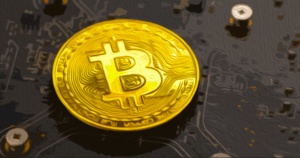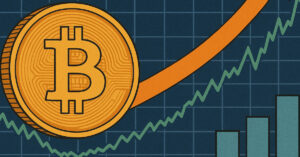
Introduction
The year-to-date performance of bitcoin (BTC), the leading digital currency by market cap, has been remarkable, with an increase of over 100%. This has sparked curiosity about the duration of its upward trajectory. Gareth Soloway, the head market strategist at inthemoneystocks.com, recently discussed the potential longevity of this rally and also touched upon the upcoming gathering of the U.S. Federal Reserve and the ascent of 10-year treasury yields to a level not seen in the last 16 years.
Federal Reserve and Market Psychology
In a Thursday interview, Gareth Soloway highlighted the Federal Reserve as the current focal point of the market. He speculated on whether the central bank will choose to raise the federal funds rate and emphasized the significance of the 10-year treasury yields surpassing 5% for the first time in 16 years. Soloway noted that a 5% yield on the 10-year treasury is crucial to the psychology of the market, and he shared Bill Gross' prediction that a recession may occur in the fourth quarter of the year, indicating a contrast in consumer confidence across different income brackets.
Bitcoin and ETF Approval
Shifting his focus to bitcoin (BTC), Soloway discussed the potential approval of a spot bitcoin exchange-traded fund (ETF). He warned that if approved, it could trigger a significant sell-off. While acknowledging bitcoin's impressive performance, Soloway questioned its resilience against a possible 15-20% asset sell-off in the Nasdaq. He expressed concerns that a 35% plunge in the stock market could eventually instill fear and panic among bitcoin holders. Soloway suggested that an ETF approval could already be factored into bitcoin's current price, leading to a potential sell-off.
The Future of Bitcoin
Looking ahead, Soloway pondered the future narratives that could drive bitcoin's price post-ETF approval. He highlighted the growing acceptance of BTC as a legitimate asset class by "big money" and compared it to gold. In times of market turmoil, he expects a surge in demand for bitcoin. Soloway predicted that the next resistance during this run-up might be around $47,000 per unit.
Possible Scenarios
Soloway acknowledged that BTC might experience a dip to the $15,000 bracket if the stock markets take a nosedive and widespread panic ensues. He emphasized that panic is a powerful emotion and could still affect bitcoin's price. In addition to monitoring bitcoin, Soloway expressed optimism about gold's potential to surge by the close of this year or in 2024. He forecasted a potential price range of $2,400 to $2,500 for gold.
Conclusion
Gareth Soloway's predictions have sparked discussions about the future of bitcoin and its resilience in the face of market turbulence. While he anticipates a potential sell-off if a spot bitcoin ETF is approved, he also sees the growing acceptance of BTC as a positive factor. As always, it is important to analyze multiple perspectives and monitor market developments to make informed decisions about investing in bitcoin and other assets.
What are your thoughts on Soloway's predictions? Share your opinions in the comments section below.
Frequently Asked Questions
Can you make money in a gold IRA
Two things are necessary if you want to make a profit on your investment. First, you need to understand the market. Second, you need to know what type of products you have.
If you don’t know anything, it is best to wait until you have enough information so that you can trade effectively.
Also, you should find the broker that provides the best service possible for your account type.
You can choose from a variety of accounts, including Roth IRAs or standard IRAs.
A rollover may be an option if you have other investments like stocks or bonds.
Which type is best for an IRA?
When choosing an IRA, it is important to choose one that suits your lifestyle and goals. It is important to consider whether you want tax-deferred, maximized growth of your contributions, reduced taxes now and paid penalties later, or just avoid taxes.
If you have little money to invest, the Roth option might make sense. It is also an option if you are still working after age 59 1/2. You can expect to pay income taxes for any accounts that are withdrawn.
If you plan on retiring early, the traditional IRA may be better because you'll likely owe any taxes on the earnings. However, if your goal is to retire early, the traditional IRA might be more sensible. The Roth IRA allows you to withdraw some of your earnings or all without paying taxes.
How much are gold IRA fees?
An individual retirement account's average annual fee (IRA) costs $1,000. There are many types to choose from, such as Roth, SEP, SIMPLE, traditional and Roth IRAs. Each type comes with its own set rules and requirements. If the earnings are not tax-deferred you could be subject to taxes. Consider how long you will keep the money. If you plan on holding onto your funds for longer, you'll likely save more money by opening a Traditional IRA rather than a Roth IRA.
A traditional IRA allows you to contribute up to $5,500 per year ($6,500 if you're 50 or older). A Roth IRA lets you contribute unlimited amounts each year. The difference between the two is simple. A traditional IRA can be withdrawn after retirement without any taxes. On the other hand, you'll owe taxes on any withdrawals made from a Roth IRA.
Statistics
- Same tax rules as traditional IRA SEP IRA contributions in 2022 are limited to 25% of compensation or $66,000, whichever is less Before setting up a Silver IRA, understand the fees and IRS restrictions. (sltrib.com)
- The maximum yearly contribution to an individual's IRAs is currently $6,000 ($7,000 for those 50 years or older), or 100% of earned income, whichever is less. (monex.com)
- To qualify as IRA allowable precious metals and be accepted by STRATA, the following minimum fineness requirements must be met: Gold must be 99.5% pure, silver must be 99.9% pure, and platinum and palladium must both be 99.95% pure. (stratatrust.com)
- You can only purchase gold bars of at least 99.5% purity. (forbes.com)
External Links
investopedia.com
kitco.com
wsj.com
regalassets.com
How To
How to Open a Precious Metal IRA
Precious Metals are one of today's most desired investment vehicles. Precious metals are a popular investment option because they provide investors with higher returns than traditional bonds and stocks. But, it is important to do your research and plan carefully before investing in precious metals. If you want to open your own precious metal IRA account, here's what you should know first.
There are two main types in precious metal accounts. These are physical precious metals and paper gold or silver certificates (GSCs). Each type has its pros and cons. GSCs and physical precious metals accounts can offer diversification, but they are difficult to trade and easy to access. Continue reading to learn more about each of these options.
Physical precious metals accounts can be used to hold bullion, coins and bars. This option is great for diversification, but it has its drawbacks. It is expensive to buy, store, and sell precious metals. They can also be very difficult to transport due to their large size.
The silver and paper gold certificates are also relatively affordable. These certificates can also be traded online, and they are easy to access. This makes them an ideal choice for those who don’t desire to invest in precious metallics. But they don't offer as much diversification as their physical counterparts. Also, since they're backed by government agencies such as the U.S. Mint, the value of these assets could decrease if inflation rates rise.
Make sure you choose the right account to suit your financial situation when opening a precious Metal IRA. Before you make that decision, here are some things to consider:
- Your tolerance level
- Your preferred asset-allocation strategy
- What time do you have available to invest?
- Consider whether you will use the funds to trade short-term.
- What kind of tax treatment you'd prefer
- Which precious metals would you prefer to invest in
- How liquid can your portfolio have to be
- Your retirement age
- You'll need somewhere to keep your precious metals
- Your income level
- Your current savings rate
- Your future goals
- Your net worth
- Special circumstances that may influence your decision
- Your overall financial picture
- You choose between paper and tangible assets
- Your willingness to take risks
- Your ability to manage losses
- Your budget constraints
- You desire to be financially independent
- Your investment experience
- Your familiarity with precious and rare metals
- Your knowledge about precious metals
- Your confidence with the economy
- Your personal preferences
Once you've chosen the right type of precious Metal IRA to suit your needs, it is time to open a dealer account. These dealers can be found via referrals, word-of-mouth, and online research.
Once your precious metal IRA has been opened, you'll need decide how much money you wish to invest. Each precious metal IRA account requires a minimum initial deposit. Some require only $100, while others will allow you to invest up to $50,000.
You can invest as much or as little money in your precious metal IRA as you like. A larger initial deposit is better if you are looking to build wealth over a longer period of time. You might prefer a lower initial deposit if you intend to invest smaller amounts every month.
You can purchase a variety of investments, regardless of whether the precious metals are actually used in your IRA. The most common include:
- Gold – Bullion bars, rounds, and coins
- Silver – Rounds or coins
- Platinum – Coins
- Palladium – Round and bar forms
- Mercury – Round or bar forms
—————————————————————————————————————————————————————————————-
Based on [POSTTITLE]
by [POSTAUTHOR]

















